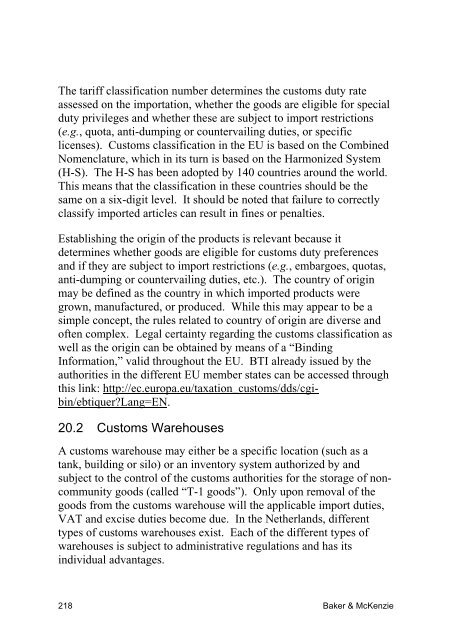Doing Business in the Netherlands 2012 - American Chamber of ...
Doing Business in the Netherlands 2012 - American Chamber of ...
Doing Business in the Netherlands 2012 - American Chamber of ...
You also want an ePaper? Increase the reach of your titles
YUMPU automatically turns print PDFs into web optimized ePapers that Google loves.
The tariff classification number determ<strong>in</strong>es <strong>the</strong> customs duty rate<br />
assessed on <strong>the</strong> importation, whe<strong>the</strong>r <strong>the</strong> goods are eligible for special<br />
duty privileges and whe<strong>the</strong>r <strong>the</strong>se are subject to import restrictions<br />
(e.g., quota, anti-dump<strong>in</strong>g or countervail<strong>in</strong>g duties, or specific<br />
licenses). Customs classification <strong>in</strong> <strong>the</strong> EU is based on <strong>the</strong> Comb<strong>in</strong>ed<br />
Nomenclature, which <strong>in</strong> its turn is based on <strong>the</strong> Harmonized System<br />
(H-S). The H-S has been adopted by 140 countries around <strong>the</strong> world.<br />
This means that <strong>the</strong> classification <strong>in</strong> <strong>the</strong>se countries should be <strong>the</strong><br />
same on a six-digit level. It should be noted that failure to correctly<br />
classify imported articles can result <strong>in</strong> f<strong>in</strong>es or penalties.<br />
Establish<strong>in</strong>g <strong>the</strong> orig<strong>in</strong> <strong>of</strong> <strong>the</strong> products is relevant because it<br />
determ<strong>in</strong>es whe<strong>the</strong>r goods are eligible for customs duty preferences<br />
and if <strong>the</strong>y are subject to import restrictions (e.g., embargoes, quotas,<br />
anti-dump<strong>in</strong>g or countervail<strong>in</strong>g duties, etc.). The country <strong>of</strong> orig<strong>in</strong><br />
may be def<strong>in</strong>ed as <strong>the</strong> country <strong>in</strong> which imported products were<br />
grown, manufactured, or produced. While this may appear to be a<br />
simple concept, <strong>the</strong> rules related to country <strong>of</strong> orig<strong>in</strong> are diverse and<br />
<strong>of</strong>ten complex. Legal certa<strong>in</strong>ty regard<strong>in</strong>g <strong>the</strong> customs classification as<br />
well as <strong>the</strong> orig<strong>in</strong> can be obta<strong>in</strong>ed by means <strong>of</strong> a “B<strong>in</strong>d<strong>in</strong>g<br />
Information,” valid throughout <strong>the</strong> EU. BTI already issued by <strong>the</strong><br />
authorities <strong>in</strong> <strong>the</strong> different EU member states can be accessed through<br />
this l<strong>in</strong>k: http://ec.europa.eu/taxation_customs/dds/cgib<strong>in</strong>/ebtiquer?Lang=EN.<br />
20.2 Customs Warehouses<br />
A customs warehouse may ei<strong>the</strong>r be a specific location (such as a<br />
tank, build<strong>in</strong>g or silo) or an <strong>in</strong>ventory system authorized by and<br />
subject to <strong>the</strong> control <strong>of</strong> <strong>the</strong> customs authorities for <strong>the</strong> storage <strong>of</strong> noncommunity<br />
goods (called “T-1 goods”). Only upon removal <strong>of</strong> <strong>the</strong><br />
goods from <strong>the</strong> customs warehouse will <strong>the</strong> applicable import duties,<br />
VAT and excise duties become due. In <strong>the</strong> Ne<strong>the</strong>rlands, different<br />
types <strong>of</strong> customs warehouses exist. Each <strong>of</strong> <strong>the</strong> different types <strong>of</strong><br />
warehouses is subject to adm<strong>in</strong>istrative regulations and has its<br />
<strong>in</strong>dividual advantages.<br />
218 Baker & McKenzie





![912.025 AmCham News [1] - American Chamber of Commerce in ...](https://img.yumpu.com/9328612/1/190x127/912025-amcham-news-1-american-chamber-of-commerce-in-.jpg?quality=85)

